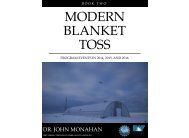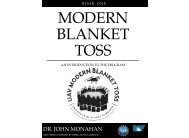Modern Blanket Toss: Findings and Observations
This book is the last in a series of three covering the National Science Foundation awarded Modern Blanket Toss project. In this book are the evaluation findings for each of the three years as well as observations from Modern Blanket Toss staff.
This book is the last in a series of three covering the National Science Foundation awarded Modern Blanket Toss project. In this book are the evaluation findings for each of the three years as well as observations from Modern Blanket Toss staff.
Create successful ePaper yourself
Turn your PDF publications into a flip-book with our unique Google optimized e-Paper software.
2016 FINDINGS<br />
INTRODUCTION<br />
The University of Alaska Fairbanks received National Science Foundation<br />
Experimental Program to Stimulate Competitive Research (EPSCoR) Track-3<br />
funding in 2013 to implement <strong>Modern</strong> <strong>Blanket</strong> <strong>Toss</strong>: Engaging Underserved<br />
Students in STEM Fields through Unmanned Aerial Vehicles. Implemented as<br />
part of the University of Alaska Fairbanks Upward Bound program, students<br />
from five rural communities in Alaska received the opportunity to take special<br />
elective classes during the Upward Bound summer program at the University of<br />
Alaska Fairbanks (UAF), in which they learned unmanned aerial vehicle (UAV)<br />
<strong>and</strong> geographic information systems (GIS) operation, science materials <strong>and</strong><br />
methods, <strong>and</strong> science communication <strong>and</strong> leadership skills. Those students were<br />
expected to return to their home communities where, with academic-year<br />
Upward Bound support, they were to use UAVs as the basis for a local mapping<br />
project.<br />
The mission of <strong>Modern</strong> <strong>Blanket</strong> <strong>Toss</strong> was to help these Upward Bound students<br />
develop interest in STEM fields through the use of technology that can directly<br />
improve the well-being of Alaskans. The project’s goal was to demonstrate how<br />
a three-part program of science education built around 1) cutting-edge STEM<br />
technologies (in this case, UAVs), 2) science communication <strong>and</strong> leadership skills,<br />
<strong>and</strong> 3) community involvement, can better expose these students to STEM<br />
careers, prepare them for higher education, <strong>and</strong> enable them to contribute to<br />
their communities.<br />
The purpose of the evaluation was to assess the effectiveness of the <strong>Modern</strong><br />
<strong>Blanket</strong> <strong>Toss</strong> program to increase the likelihood that participating students would<br />
go on to pursue college degrees in STEM areas <strong>and</strong> ultimately pursue STEM<br />
careers. This report provides the summative evaluation results. The report is<br />
divided into four sections. Section 1 describes the primary methods used by the<br />
evaluation, including student surveys <strong>and</strong> interviews, academic data, <strong>and</strong> surveys<br />
of Upward Bound site coordinators. This section also discusses the limitations of<br />
the evaluation methods. Section 2 summarizes the implementation of the<br />
program, including a description of the Upward Bound communities<br />
participating in the program <strong>and</strong> the number of students participating. Section 3<br />
summarizes the evaluation results by the indicators used to measure the<br />
program’s effectiveness, including 1) Upward Bound local coordinator capacity<br />
to facilitate the program locally; 2) student satisfaction <strong>and</strong> engagement with<br />
program activities; 3) student knowledge about the <strong>Modern</strong> <strong>Blanket</strong> <strong>Toss</strong><br />
content; 4) student communication <strong>and</strong> leadership skills; 5) student interest <strong>and</strong><br />
confidence in STEM; <strong>and</strong> 6) student academic data including their overall grade<br />
point average <strong>and</strong> their math <strong>and</strong> science course grades specifically. Section 4<br />
provides a brief discussion of the major findings <strong>and</strong> recommendations to<br />
address challenges identified in the report.<br />
SECTION 1. EVALUATION METHODS<br />
The purpose of the evaluation was to assess the effectiveness of the <strong>Modern</strong><br />
<strong>Blanket</strong> <strong>Toss</strong> program in increasing the likelihood that participating students<br />
would go on to pursue college degrees in STEM areas <strong>and</strong> ultimately pursue<br />
STEM careers. A descriptive approach was used to evaluate indicators related to<br />
the implementation of the program: Upward Bound local coordinator capacity<br />
to facilitate the program locally, <strong>and</strong> student satisfaction <strong>and</strong> engagement with<br />
program activities. An outcomes-based approach (Phillips et al., 2014) was used<br />
to evaluate indicators related to the program’s expected outcomes, including:<br />
student knowledge about the <strong>Modern</strong> <strong>Blanket</strong> <strong>Toss</strong> content, student<br />
communication <strong>and</strong> leadership skills, student interest in STEM <strong>and</strong> confidence in<br />
STEM abilities, <strong>and</strong> student academic data including their overall grade point<br />
average <strong>and</strong> their math <strong>and</strong> science course grades specifically (Dorsen et al.,<br />
2006; Hinojosa et al., 2016).<br />
To measure the program’s impact on selected indicators, the evaluation used<br />
several data sources: student <strong>and</strong> coordinator surveys, student interviews,<br />
academic data, observation field notes, <strong>and</strong> document review. Figure 1 maps<br />
each indicator to the appropriate data collection instrument.<br />
Site Coordinator Survey<br />
37




